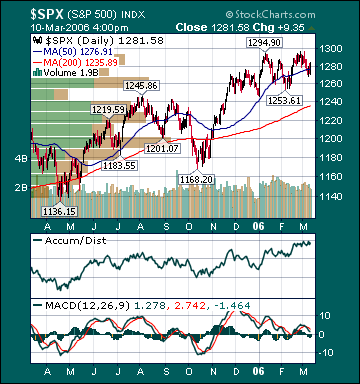
Click here for the Weekly Wrap by Briefing.com.
BOTTOM LINE: Overall, last week's market performance was mildly bearish considering the fall in energy prices, mostly positive economic data and a rise in the US dollar. The advance/decline line fell, most sectors declined and volume was above average on the week. Measures of investor anxiety were mixed. The AAII % Bulls rose slightly to 41.21%, but is still below average levels, which is a positive. The average 30-year mortgage rate rose to 6.37% which is 116 basis points above all-time lows set in June 2003. The benchmark 10-year T-note yield rose 7 basis points on the week as most economic data points were positive and worries over perceived inflation increased. The 10-year yield is still 18 basis points lower than it was in 2004 and 202 basis points below levels at the peak of the bubble in 2000. I expect inflation concerns to peak over the next few weeks and decline through year-end as economic growth slows to average levels, unit labor costs remain subdued and commodity prices weaken further.
Unleaded Gasoline futures fell for the week and have collapsed 41.8% from September highs even as refinery utilization remains below normal as a result of the hurricanes last year, 23.2% of Gulf of Mexico oil production remains shut-in and fears over Iranian/Nigerian production disruptions persist. Natural gas inventories fell less than expected this week. Supplies are now 54.3% above the 5-year average, near an all-time record high for this time of year, even as 14.0% of daily Gulf of Mexico production remains shut-in. Natural gas prices have plunged 57.9% in 12 weeks. Many oil bulls point to the potential for a supply disruption as the main reason oil prices remain extremely elevated while fundamentals for the commodity deteriorate. I would point out that natural gas bulls used the same rationale before the historic supply disruptions related to the hurricanes. This did not prevent a collapse in the price of natural gas. I continue to expect deteriorating fundamentals for oil to trump fear over the intermediate-term, thus sending prices substantially lower. Gold fell for the week as the US dollar rose and energy prices fell. The US dollar gained on continued economic strength relative to other developed nations and rising expectations for more Fed rate hikes.
The CRB Index closed the week convincingly below its 200-day moving average for the first time in almost 5 years. A weekly close below 310 would place the uptrend in commodities that began in 2001 in jeopardy. I expect this to occur over the coming weeks. Weakness in commodity prices led to substantial underperformance by most commodity stocks this week. Technology stocks underperformed, as well, as fears over rising long-term rates sent most high growth stocks lower. The average stock, as measured by the Value Line Geometric Index(VGY), is still up a strong 4.8% so far this year. A 19% rise in this index in less than a year has resulted in the current period of consolidation. While it appears this action could continue a bit longer, I do not expect much more downside in the major averages from current levels. I expect technology, biotechnology, medical, retail, restaurant, gaming, telecom, airline and select financial stocks to provide the leadership for the next push higher in the major averages. The ECRI Weekly Leading Index fell again slightly and is still forecasting healthy, but decelerating, US economic activity.
*5-day % Change